If you’re looking for a small and colorful fish to add to your aquarium, the Red Eye Tetra is an excellent choice. These fish are hardy and easy to care for, making them perfect for beginners and experienced fish keepers alike. In this article, I’ll cover everything you need to know about Red Eye Tetra care, including tank setup, water quality, tank mates, diet, common diseases, breeding, and more!
Red Eye Tetras require a well-maintained aquarium with suitable water conditions, a varied diet, and a peaceful environment. They need a pH range of 6.0-7.5 and a temperature range between 72-82°F. The aquarium should be planted, and regular water changes should be performed to ensure their health. They are peaceful and social fish, making them an excellent choice for community tanks.
When I first got into fish keeping, I was drawn to the vibrant colors of the Red Eye Tetra. I quickly learned that these fish are not only beautiful, but also easy to care for. To ensure your Red Eye Tetras thrive in your aquarium, it’s important to set up their tank properly. This includes providing plenty of hiding places, as well as a well-filtered and heated tank. In addition, maintaining good water quality is crucial to keeping your fish healthy and happy.
While Red Eye Tetras can be kept with other peaceful fish, it’s important to choose tank mates carefully. These fish are relatively small, so avoid keeping them with larger or aggressive fish that may bully them. In terms of diet, Red Eye Tetras are omnivores and will eat a variety of foods, including flakes, pellets, and frozen or live foods. By following these tips and guidelines, you can ensure your Red Eye Tetras live long and healthy lives in your aquarium.
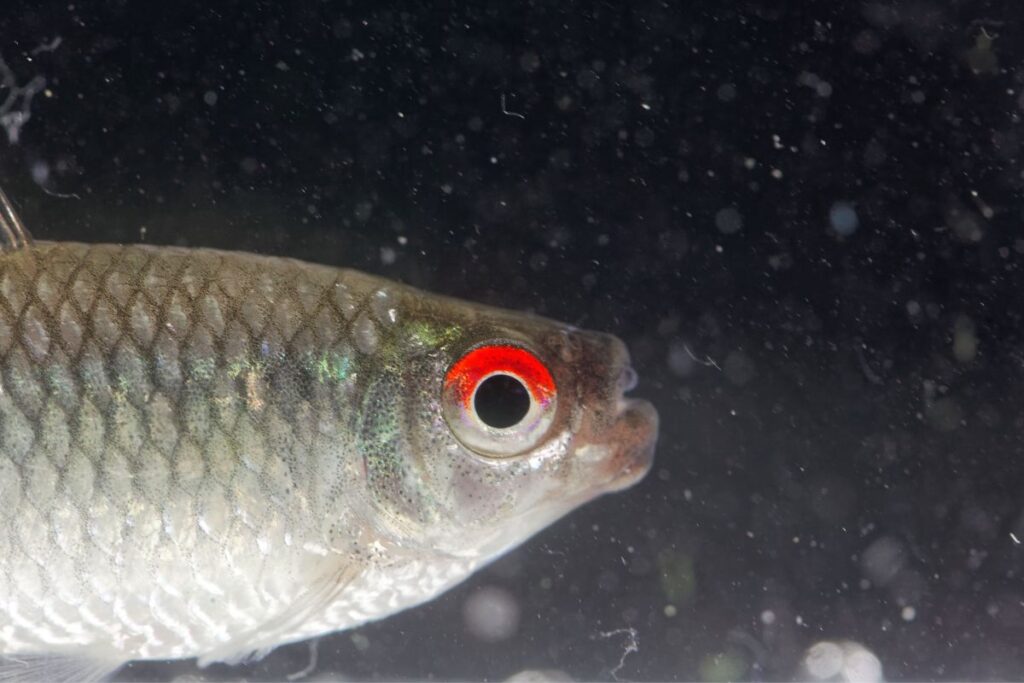
Table of Contents
Species Summary
Red eye tetras are a popular freshwater fish known for their vibrant red eyes and active behavior.
In this section, we’ll take a closer look at the key characteristics of these fish, including their origins, lifespan, appearance, size, growth rate, behavior and temperament, and differences between males and females.
Origin
Red eye tetras are native to the Amazon basin in South America, where they can be found in slow-moving streams and tributaries.
They are typically found in areas with dense vegetation and plenty of hiding places.
Lifespan
Red eye tetras have a relatively short lifespan, typically living for 3-5 years in captivity.
However, with proper care and attention, some individuals have been known to live up to 7 years.
Appearance
Red eye tetras are small, slender fish with a distinctive red eye and silver body.
They have a forked tail and a slightly pointed snout, and their fins are transparent with a slight orange tint.
Size
Red eye tetras typically grow to be around 1.5-2 inches in length, making them a great choice for smaller aquariums.
However, they are also known for their active behavior and can benefit from a larger tank with plenty of swimming space.
Growth rate
The growth rate of red eye tetras can vary depending on a number of factors, including water quality, diet, and tank size. However, in general, these fish will reach their full size within the first year of life.
Behavior & Temperament
Red eye tetras are active, social fish that do well in groups of 6 or more. They are generally peaceful and non-aggressive, making them a great choice for community aquariums.
However, they can become nippy if kept in too small of a group or with more aggressive tank mates.
Male vs Female
Male and female red eye tetras can be difficult to tell apart, as they have similar coloring and body shape. However, females may be slightly larger and have a slightly rounder belly when full of eggs.
Overall, red eye tetras are a great choice for both beginner and experienced aquarists. With their vibrant coloration and active behavior, they make a beautiful and engaging addition to any freshwater aquarium.
Personally, I have kept red eye tetras in my own aquarium for several years and have found them to be a joy to watch. Their active behavior and social nature make them a great choice for anyone looking to add some life to their tank.
Tank Setup
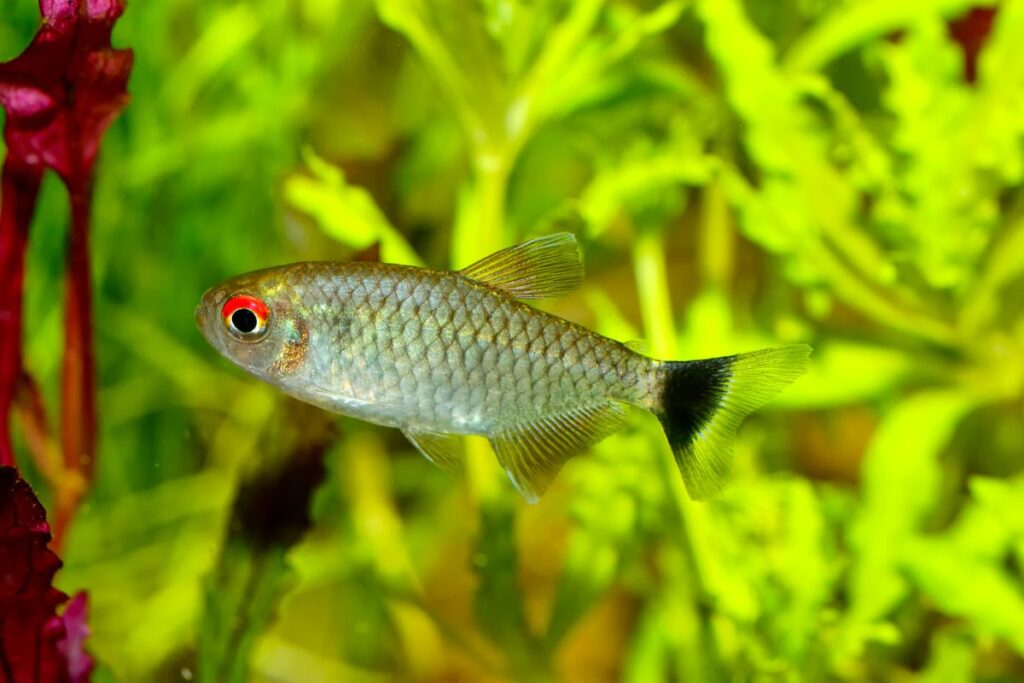
Tank Size
When setting up a tank for red eye tetras, it’s important to consider the size of the tank. I recommend a minimum tank size of 20 gallons for a small group of 6-8 tetras. This will give them enough space to swim and explore.
Lighting
Red eye tetras prefer dim lighting, so it’s best to use a low-intensity light or provide some shade with floating plants. This will also help to reduce algae growth in the tank.
Filtration System
A good filtration system is essential for maintaining water quality in the tank. I recommend using a hang-on-back filter or a canister filter. Be sure to choose a filter that is rated for the size of your tank.
Aeration
Red eye tetras require well-oxygenated water, so it’s important to provide adequate aeration. This can be achieved with an air stone or a bubble wand.
Heater
Maintaining a stable water temperature is crucial for the health of red eye tetras. I recommend using a submersible heater to keep the water temperature between 75-80°F.
Substrate
Red eye tetras prefer a sandy substrate, as it mimics their natural habitat. Avoid using sharp or coarse substrates that can damage their delicate fins.
Plants and Decorations
Adding live plants and decorations to the tank can provide hiding places and create a more natural environment for red eye tetras.
I recommend using plants such as Amazon swords, java ferns, and moss balls. Be sure to choose decorations that are smooth and won’t harm the tetras. Overall, setting up a tank for red eye tetras requires careful consideration of their natural habitat and needs.
By providing a suitable tank size, lighting, filtration system, aeration, heater, substrate, and decorations, you can create a healthy and thriving environment for these beautiful fish.
Water Quality
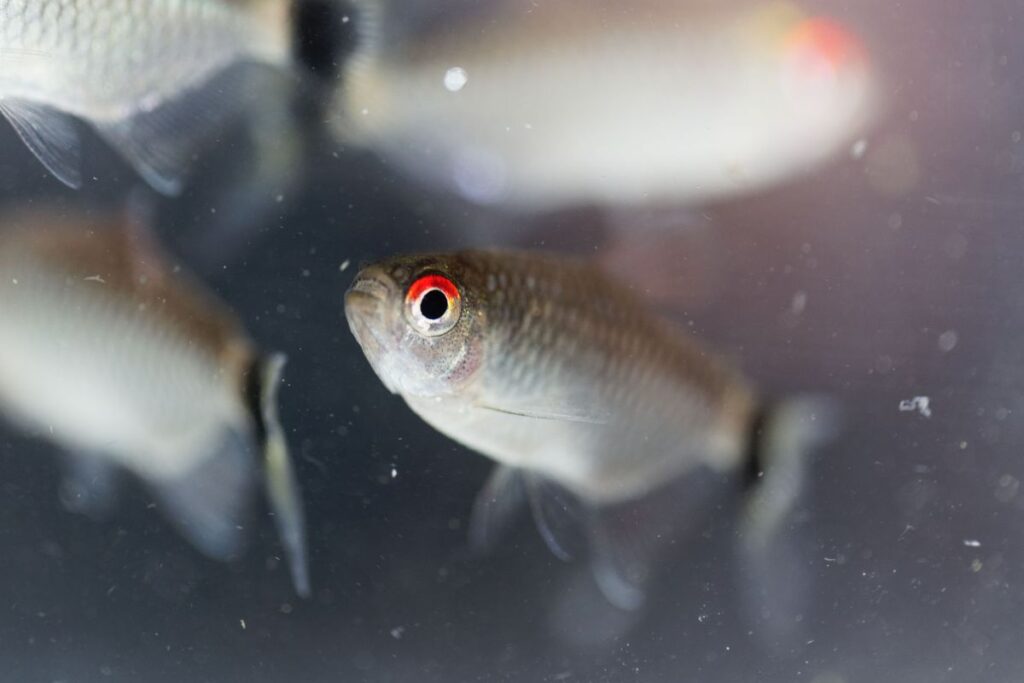
As a Red Eye Tetra owner, it’s important to maintain good water quality in your tank. Poor water quality can lead to stress, disease, and even death.
Here are some important factors to consider when it comes to water quality:
Temperature
Maintaining the right temperature is crucial for the health of your Red Eye Tetras. I keep my tank at around 75-80°F (24-27°C), which seems to work well for them.
It’s important to avoid sudden temperature changes, as this can stress your fish and make them more susceptible to disease.
pH Level
Red Eye Tetras prefer slightly acidic water, with a pH level between 6.0 and 7.0. I use a pH testing kit to monitor the pH level in my tank and make adjustments as needed.
It’s important to avoid drastic changes in pH, as this can also stress your fish.
Water Hardness
Red Eye Tetras prefer soft to medium-hard water, with a hardness level between 5 and 12 dGH.
I use a water hardness testing kit to monitor the hardness level in my tank and make adjustments as needed.
Water Changes
Regular water changes are important for maintaining good water quality in your tank. I do a 25% water change once a week, which seems to work well for my Red Eye Tetras.
It’s important to use a water conditioner to remove any chlorine or other chemicals from tap water before adding it to your tank.
Overall, maintaining good water quality is essential for the health and well-being of your Red Eye Tetras.
By monitoring temperature, pH level, water hardness, and doing regular water changes, you can ensure that your fish thrive in their environment.
Tank Mates
Suitable Tank Mates
When it comes to choosing tank mates for your Red eye tetras, there are several options to consider. These fish are generally peaceful and do well in community tanks. Some suitable tank mates include:
- Other small, peaceful fish such as neon tetras, guppies, and rasboras
- Corydoras catfish
- Otocinclus catfish
- Small snails
I personally have had success keeping my Red eye tetras with neon tetras and corydoras catfish.
They all get along well and create a beautiful display in my tank.
Incompatible Tank Mates
While Red eye tetras are generally peaceful, there are some fish that should be avoided as tank mates. These include:
- Aggressive fish such as cichlids and bettas
- Large fish that may see the tetras as food
- Fast-swimming fish that may stress out the tetras
It’s important to do your research and choose tank mates that will get along well with your Red eye tetras. Introducing incompatible fish can lead to stress, aggression, and even death.
Keeping Red Eye Tetras Together
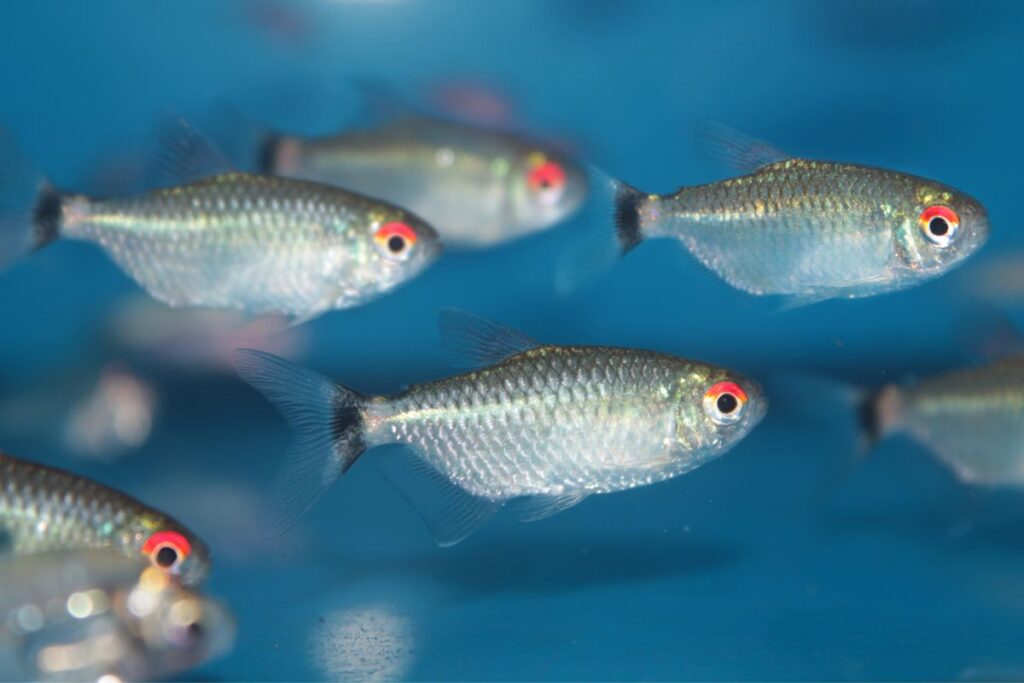
As an avid fish keeper, I have found that Red Eye Tetras are a great addition to any aquarium. They are active, colorful, and easy to care for.
However, it is important to consider the number of tetras you keep together as they are a schooling fish.
It is recommended to keep a minimum of six Red Eye Tetras together, but I have found that a group of ten or more is ideal.
This allows them to establish a hierarchy and feel more comfortable in their environment. Keeping them in smaller groups can lead to stress and aggression.
When setting up your tank, make sure to provide plenty of hiding spots and plants for them to swim through.
This will help reduce stress and provide a more natural environment for them. It is also important to maintain proper water quality to ensure their health and well-being.
When choosing tank mates for your Red Eye Tetras, it is best to avoid aggressive or larger fish that may see them as prey.
Good tank mates include other small, peaceful fish such as neon tetras, guppies, or rasboras.
In terms of diet, Red Eye Tetras are omnivores and will eat a variety of foods including flakes, pellets, and live or frozen foods such as brine shrimp or bloodworms.
It is important to provide a balanced diet to ensure their health and vitality.
While Red Eye Tetras are generally hardy fish, they are susceptible to common diseases such as ich and fin rot.
It is important to monitor their behavior and appearance regularly and take action if necessary.
If you are interested in breeding Red Eye Tetras, it is best to set up a separate breeding tank. They are egg scatterers and will lay their eggs on plants or other surfaces. The eggs will hatch in 24-48 hours and the fry will become free-swimming after a few days.
Overall, Red Eye Tetras are a great addition to any aquarium. By keeping them in a group of at least six and providing a suitable environment, you can enjoy their vibrant colors and active behavior for years to come.
Diet
Types of Food
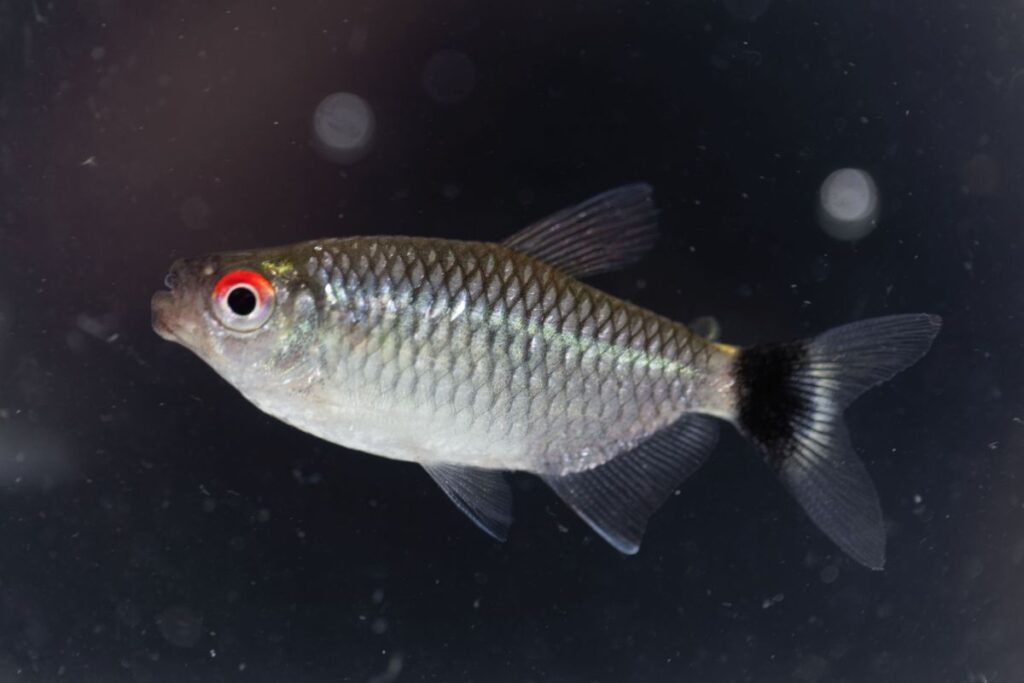
Red eye tetras are omnivores and will eat a variety of foods. In the wild, they primarily feed on insects, small crustaceans, and plant matter. In captivity, they can be fed a diet of flakes, pellets, frozen or live foods.
I personally prefer to feed my red eye tetras a combination of flakes and frozen foods, such as bloodworms and brine shrimp.
It’s important to vary their diet to ensure they are receiving all the necessary nutrients. You can also supplement their diet with fresh vegetables, such as blanched spinach or zucchini.
Amount of Food
When it comes to feeding red eye tetras, it’s important to not overfeed them. Overfeeding can lead to health issues and poor water quality.
I recommend feeding them small amounts twice a day, only what they can consume in 2-3 minutes.
As a general rule of thumb, feed them an amount that is equivalent to the size of their eye. This will ensure they are receiving enough food without overfeeding them.
Feeding Frequency
Red eye tetras are active fish and require regular feeding. I feed my red eye tetras twice a day, once in the morning and once in the evening.
It’s important to establish a feeding schedule and stick to it to ensure they are receiving enough food.
It’s also important to note that red eye tetras are schooling fish and should be fed in a group. This will help prevent any aggression during feeding time and ensure all fish are receiving enough food.
Overall, providing a varied diet and feeding them in small amounts twice a day will help keep your red eye tetras healthy and happy.
Common Diseases
Diseases
Red eye tetras are generally hardy fish that can tolerate a variety of water conditions. However, they are still susceptible to a few diseases.
One common disease is Ich, which is caused by a parasitic protozoan. Symptoms include white spots on the fish’s body and fins, as well as scratching against objects in the tank.
Another disease to watch out for is fin rot, which is caused by bacteria and can lead to the deterioration of the fins.
Dropsy is another disease that can affect red eye tetras, which is caused by a bacterial infection and can result in bloating, pinecone-like scales, and lethargy.
Symptoms
It is important to monitor your red eye tetras for any signs of illness. Symptoms of Ich include white spots on the body and fins, as well as scratching against objects in the tank.
Fin rot is characterized by the deterioration of the fins, while Dropsy can lead to bloating, pinecone-like scales, and lethargy.
Keeping a close eye on your fish and noticing any changes in behavior or appearance can help you catch and treat diseases early.
Prevention
The best way to prevent diseases in red eye tetras is to maintain good water quality.
Perform regular water changes, keep the tank clean, and test the water regularly to ensure that the parameters are within the appropriate range.
Avoid overcrowding the tank, as this can lead to stress and increased susceptibility to disease. Quarantining new fish before adding them to the tank can also help prevent the introduction of diseases.
Treatment
If you notice any signs of illness in your red eye tetras, it is important to take action quickly. For Ich, you can treat the tank with medication specifically designed to combat the parasite.
For fin rot, remove any affected fish and treat the tank with antibiotics.
Dropsy can be more difficult to treat, but raising the temperature of the tank and adding aquarium salt can help.
If you are unsure of how to treat a specific disease, consult with a veterinarian or experienced fish keeper.
Personally, I have dealt with Ich in my red eye tetras before. I noticed my fish scratching against objects in the tank and saw white spots on their bodies. I immediately treated the tank with medication and performed a water change. Within a few days, the symptoms had disappeared and my fish were back to their healthy selves.
Signs of a Healthy Redeye Tetra
I have been keeping Redeye Tetras in my aquarium for years, and over time, I have learned to recognize the signs of a healthy fish. Here are some things to look out for when assessing the health of your Redeye Tetra:
Physical Appearance: A healthy Redeye Tetra should have bright and vibrant colors. The fins should be intact, and the body should be free of any visible wounds or blemishes. The eyes should be clear and not cloudy or bulging.
Active Swimming: A healthy Redeye Tetra should be active and swim around the tank with ease. If you notice your fish hiding or staying in one spot for an extended period, it could be a sign of illness.
Appetite: A healthy Redeye Tetra should have a good appetite and eagerly eat when food is offered. If your fish is not eating or appears to be losing weight, it could be a sign of an underlying health issue.
Behavior: A healthy Redeye Tetra should be social and interact with other fish in the tank. If you notice your fish isolating itself or behaving abnormally, it could be a sign of stress or illness. In addition to these signs, regularly monitoring the water quality of your aquarium is crucial in maintaining the health of your Redeye Tetras. By observing these indicators, you can quickly identify and address any potential health issues before they become more severe.
Signs of a Sick Redeye Tetra
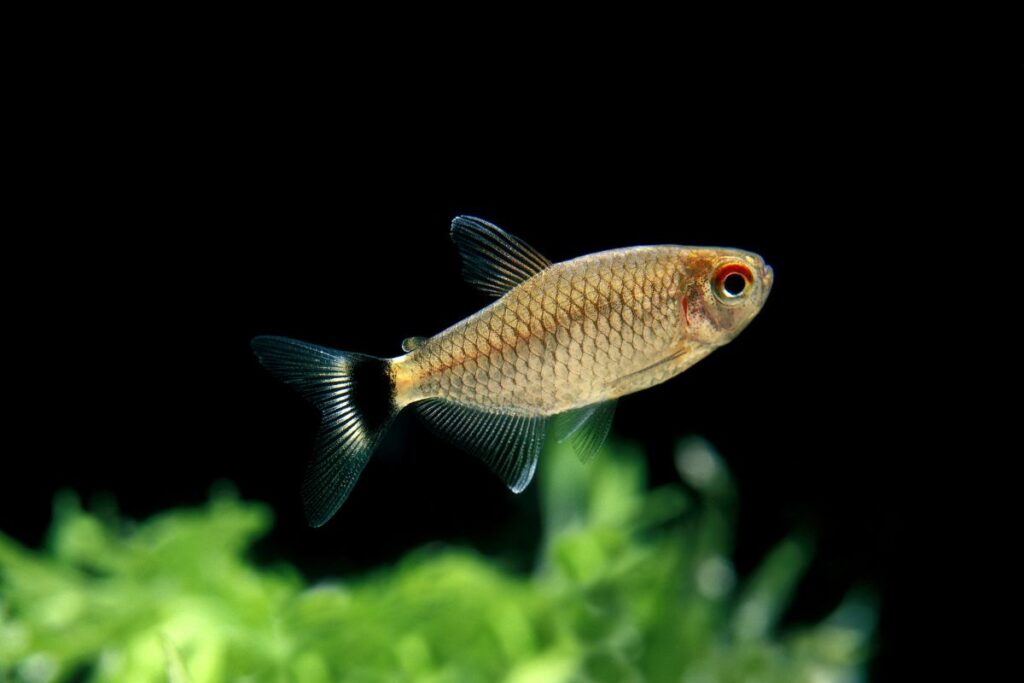
When it comes to keeping Redeye Tetras healthy, it’s important to know the signs of illness. Here are some common symptoms to look out for:
Loss of Appetite: If your Redeye Tetra is not eating, it could be a sign of illness. Observe your fish closely to see if it is eating or not.
Abnormal Swimming: If your Redeye Tetra is swimming erratically or has difficulty swimming, it could be a sign of illness. Check to see if your fish is swimming upright and not tilting to one side.
Discolored or Faded Appearance: If your Redeye Tetra is looking pale or has lost its vibrant color, it could be a sign of illness. Check the water quality and make sure it is within the recommended parameters.
Visible Sores or Lesions: If you notice any visible sores or lesions on your Redeye Tetra, it could be a sign of bacterial infection. Quarantine the fish and treat it with an appropriate medication.
Gasping for Air: If your Redeye Tetra is gasping for air at the surface of the water, it could be a sign of poor water quality or lack of oxygen.
Check the water parameters and ensure proper aeration and filtration. I once had a Redeye Tetra that showed signs of illness.
It was swimming erratically and had difficulty swimming upright. I immediately quarantined it and treated it with medication.
Within a few days, it was back to its normal self. It’s important to act quickly when you notice any signs of illness in your Redeye Tetras.
Breeding
Breeding Setup
When it comes to breeding Red eye tetras, it is important to provide them with the right environment. You will need a separate breeding tank with a capacity of at least 10 gallons.
The tank should be well planted with plenty of hiding places for the fish to lay their eggs. You will also need a heater to maintain a temperature of 78-82°F and a sponge filter to keep the water clean.
Breeding Process
The breeding process of Red eye tetras is relatively easy. Once you have set up the breeding tank, you can introduce a pair of mature Red eye tetras.
The male will begin to chase the female around the tank, and when she is ready to lay eggs, he will lead her to a suitable spot.
The female will then lay her eggs, which the male will fertilize. You can expect the female to lay around 100-200 eggs.
After the eggs have been laid, you should remove the adult fish from the breeding tank to prevent them from eating the eggs.
The eggs will hatch in 24-36 hours, and the fry will become free-swimming after 5-7 days. At this point, you can begin feeding them with newly hatched brine shrimp or commercial fry food.
Fry Care
Caring for Red eye tetra fry is not difficult, but it does require some attention to detail. You will need to keep the water clean by doing regular water changes of 25% every other day.
It is also important to feed the fry small amounts of food several times a day. You can gradually increase the amount of food as they grow.
It is also important to keep the temperature of the water consistent and maintain good water quality. You can use a sponge filter to help keep the water clean and aerated.
With proper care, your Red eye tetra fry will grow quickly and be ready to move to a larger tank in a few weeks.
When I first tried breeding Red eye tetras, I was a little nervous about the process. But with a little research and some patience, I was able to successfully breed them.
Watching the fry grow and develop was a truly rewarding experience, and I would highly recommend it to anyone who is interested in breeding fish.
Product recommendations for Red Eye Tetra Care:
- TetraMin Plus Tropical Flakes:: This high-quality fish food is specifically formulated for tropical fish like Red Eye Tetras, providing a balanced diet that promotes health and vitality.
- Seachem Prime: This water conditioner is essential for maintaining a healthy aquatic environment for Red Eye Tetras. It detoxifies ammonia, nitrite, and nitrate, and also provides essential electrolytes and vitamins.
- API Freshwater Master Test Kit: This comprehensive test kit allows you to monitor the water quality in your Red Eye Tetra aquarium, ensuring that the pH, ammonia, nitrite, and nitrate levels are within safe ranges.
- Hikari Micro Pellets: Red Eye Tetras love micro pellets, and these nutrient-rich pellets are a convenient and nutritious treat that can be fed as a supplement to their regular diet.
- Fluval Edge Aquarium Gravel Cleaner: This easy-to-use gravel cleaner makes maintaining your Red Eye Tetra aquarium a breeze. It removes debris and waste from the substrate without disturbing your fish.
- Aqueon QuietFlow LED PRO Aquarium Power Filters: This high-performance filter is designed to keep your Red Eye Tetra aquarium clean and healthy. It features a five-stage filtration system and LED lighting for added convenience.
- Marina Floating Thermometer with Suction Cup: This reliable thermometer ensures that the water temperature in your Red Eye Tetra aquarium is within the ideal range. Its floating design makes it easy to read and adjust.
- Marina Tank Scraper: This versatile tool allows you to clean the glass, remove algae, and scrape the substrate in your Red Eye Tetra aquarium. Its ergonomic design makes it comfortable to use.
- Zoo Med Aquatic BettaMatic Automatic Daily Betta Feeder: This automatic fish feeder is perfect for busy fish owners who want to ensure that their Red Eye Tetras are fed on a regular schedule. It dispenses food automatically and can be programmed to feed up to three times per day.
Conclusion
Overall, I have found that Red Eye Tetras are a delightful addition to any aquarium. With their vibrant colors and active personalities, they are sure to bring joy to any fish keeper. However, it is important to ensure that they are kept in a suitable environment with proper care.
When setting up a tank for Red Eye Tetras, it is important to provide them with plenty of hiding places and a well-planted aquarium. It is also crucial to maintain good water quality by performing regular water changes and monitoring the levels of ammonia, nitrite, and nitrate.
When it comes to tank mates, Red Eye Tetras are generally peaceful and can coexist with other small, non-aggressive fish. However, it is best to avoid keeping them with fin nippers or larger, more aggressive fish.
When it comes to their diet, Red Eye Tetras are not picky eaters and will readily accept a variety of foods. It is important to provide them with a balanced diet that includes both dry and frozen foods.
While Red Eye Tetras are generally hardy fish, they are susceptible to common fish diseases such as ich and fin rot. It is important to monitor their behavior and appearance regularly and take action if any signs of illness are present.
Lastly, breeding Red Eye Tetras can be a rewarding experience for experienced fish keepers. However, it is important to provide them with the proper conditions and to be patient, as breeding can be a slow process.
In conclusion, Red Eye Tetras are a wonderful addition to any aquarium and can provide years of enjoyment for their owners. With proper care and attention, they can thrive and bring color and life to your tank.
Personally, I have found that Red Eye Tetras are one of the most captivating fish to watch in my aquarium. Their playful personality and vibrant colors always bring a smile to my face. I highly recommend them to any fish keeper looking for a lively and colorful addition to their tank.
FAQs
As a Red Eye Tetra owner, I have come across many questions regarding their care. Here are some of the most frequently asked questions:
Q: What should be the ideal tank setup for Red Eye Tetras?
A: Red Eye Tetras are schooling fish and need to be kept in groups of at least six. A 20-gallon tank is ideal for a small group of Red Eye Tetras. The tank should be well-planted, and the water flow should be moderate. A dark substrate and floating plants will help to mimic their natural habitat.
Q: What is the ideal water quality for Red Eye Tetras?
A: Red Eye Tetras are sensitive to changes in water parameters. The ideal temperature range for them is between 72-82°F, and the pH level should be between 6.0-7.5. The water should be soft to moderately hard, with a maximum hardness of 10 dGH.
Q: What are the ideal tank mates for Red Eye Tetras?
A: Red Eye Tetras are peaceful fish and can be kept with other small, peaceful fish such as Neon Tetras, Corydoras, and Guppies. Avoid keeping them with aggressive or larger fish.
Q: What is the ideal diet for Red Eye Tetras?
A: Red Eye Tetras are omnivores and will eat a variety of foods. Their diet should consist of high-quality flakes, pellets, and frozen or live foods such as brine shrimp and bloodworms. Feed them twice a day, only what they can consume in a few minutes.
Q: What are some common diseases that affect Red Eye Tetras?
A: Red Eye Tetras are susceptible to diseases such as Ich, Fin Rot, and Velvet. Regular water changes and maintaining good water quality can help prevent these diseases.
Q: How can I breed Red Eye Tetras?
A: Breeding Red Eye Tetras is relatively easy. Provide them with a separate breeding tank with soft, acidic water and a temperature of around 78°F. The female will lay eggs on the plants, and the male will fertilize them. Remove the parents after spawning to prevent them from eating the eggs. The eggs will hatch in 24-36 hours, and the fry will become free-swimming in about five days.
These are some of the most frequently asked questions about Red Eye Tetra care. If you have any other questions, feel free to ask your local fish store or a knowledgeable fish keeper.
Reference: Wikipedia.
